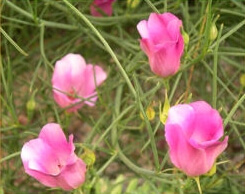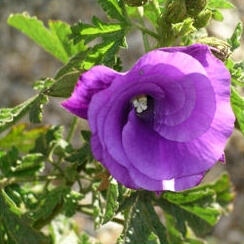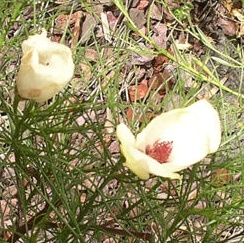I’ve grown quite a few Alyogyne hakeifolia over the years. The best feature of this Alyogyne hakeifolia 'Melissa Anne' would have to be the deep purple tulip type flowers which occur on mass over summer.
More...
Alyogyne ‘Melissa Anne’ Plant Features

Alyogyne hakeifolia 'Melissa Anne'
There aren’t many plants around that actually flower this well over summer so it may quite possibly be the only plant you may have in your garden that’s flowering at this time of the year.
The other great thing about the Alyogyne 'Melissa Anne' is that it is very drought tolerant and actually seems to thrive on a lack of water. It comes from the desert areas of South and Western Australia and has very long needle-like leaves which are a little bit succulent like and obviously help with its drought tolerance.
The leaves are a deep green colour and actually seem to glisten in the sun on a hot day which adds to its appearance.
Ideal Conditions for Alyogyne hakeifolia ‘Melissa Anne’
This Alyogyne grows to about 2 m and it is best if it is pruned quite hard after flowering as it can grow very tall and lean and as the branches can be quite brittle this will help it with its wind tolerance.
The best place to plant Alyogyne hakeifolia is in full sun in a raised bed or well drained soil in an area sheltered from the wind. Also never fertilise this plant as despite not being a member of the Proteaceae family, it still really doesn’t like fertilisers with Phosphorus as this will probably kill the plant.

Alyogyne huegelii
The other type of Alyogyne that is popular is Alyogyne huegelii but I think I will cover this in a separate article.

Alyogyne hakeifolia ‘Elle Marie’
Alyogyne hakeifolia also has a variation called Alyogyne hakeifolia ‘Elle Marie’ that has creamy yellow flowers which look great as a contrast but don’t look quite as good as the purple ones. But that’s just a personal choice.
Published on June 23, 2023 by AGT
Last Updated on January 28, 2024




